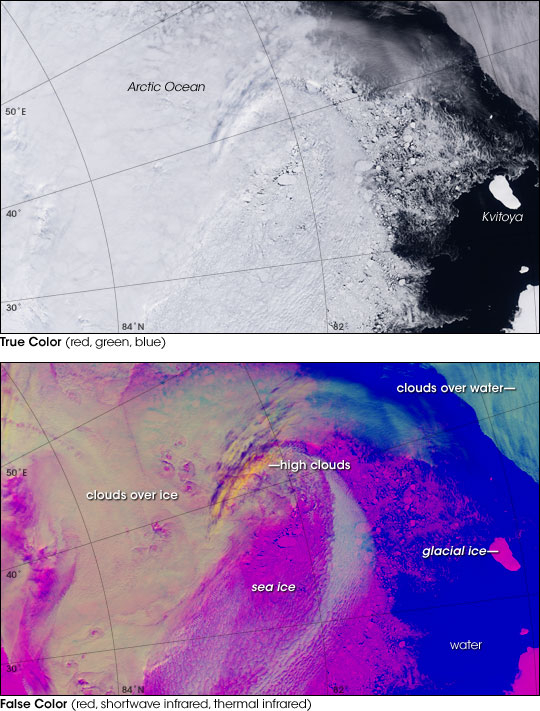


In a photo-like satellite image, the faintest of shadows or shading of grey may give them away, but more often, clouds over the poles simply disappear against the background, camouflaged from the satellite’s view by the underlying snow and sea ice. For those trying to track clouds from space, to understand cloud physics, say, or to predict the weather, the problem is frustrating. Only with a combination of visible and invisible wavelengths of light, such as infrared light, do clouds become distinct from the snow and ice below.
One of NASA’s sensors that has the capability of detecting many visible and infrared wavelengths of light is the Moderate Resolution Imaging Spectroradiometer (MODIS), a version of which flies on both the Terra and Aqua satellites. Because MODIS “sees” in both infrared and visible light, it can provide a picture of cloud cover in the Arctic, as shown in this pair of images.
The top image shows the Arctic Ocean in visible light, as it would look to a human flying over in an airplane or in a digital photograph. The lower image shows the same view in a combination of visible and infrared light. In this light, clouds take on a slight orange tint, while the underlying sea ice and the land-based glacial ice over Kvitoya Island become bright purple. Ocean water goes from nearly black in visible light to bright blue in infrared. In the visible image, only the high clouds that cast their shadow on the cloud and ice below them are visible, but the infrared image reveals a large bank of clouds over the ice.
Finding such elusive Arctic clouds is a key element in understanding how global warming might impact the region. For Seiji Kato, an atmospheric scientist affiliated with NASA’s Langley Research Center through Hampton University, such MODIS images helped him determine that the Arctic got cloudier between 2000 and 2004. Kato discovered the increase in clouds while trying to detect changes in the amount of incoming sunlight the Earth’s polar regions reflect.
In the Arctic, ice and snow reflect light back into space, which prevents the surface from soaking up sunlight and warming up. Dark water, by contrast, absorbs sunlight and heats up. If warming temperatures, such as those caused by global warming, melt the ice, then the water will absorb incoming sunlight and heat up, which amplifies the initial warming. At the same time, more open water means that more water vapor can build in the atmosphere and more clouds can form. Like ice, clouds reflect light back into space, which could dampen warming by shielding the surface from light.
Since Arctic sea ice had been declining rapidly in recent years, Kato wondered if the poles had become less reflective as a result. To answer the question, Kato and several teammates compared a suite of NASA and NOAA (National Oceanic and Atmospheric Administration) satellite observations of reflected sunlight, clouds, and sea ice and snow cover at polar latitudes from 2000-2004. No trends were detected in the Antarctic, but in the Arctic, sea ice had definitely declined. Interestingly, the amount of light reflected had not changed. The reason? An increase in clouds compensated for the loss in snow and sea ice. To read more about the team’s investigation, read the Earth Observatory feature story Arctic Reflection: Clouds Replace Snow and Ice as Solar Reflector.
NASA images by Robert Simmon and Jesse Allen, based on MODIS data.